Process and Mechanism of Agricultural Irrigation Benefit Allocation Coefficient Based on Emergy Analysis—A Case Study of Henan, China
Abstract
1. Introduction
2. Materials and Methods
2.1. Study Area
2.2. Data Collection
2.3. Methods
3. Results and Discussion
3.1. Emergy Flow Analysis of the Henan Agricultural Production System
- Renewable environmental resource emergy, such as solar energy, irrigation water, chemical energy from rainfall, and potential energy from rainfall;
- Non-renewable environmental resource emergy, such as topsoil loss;
- Non-renewable industrial emergy, such as agricultural electricity, agricultural machinery, pesticides, chemical fertilizers, agricultural film, and fuel oil;
- Renewable organic emergy, such as agricultural labor and crop seeds.
3.2. City-Wise Evaluation of Irrigation Benefit Allocation Coefficient
3.3. Variation Mechanism and Influencing Factors of Irrigation Benefit Allocation Coefficient
4. Conclusions
Author Contributions
Funding
Conflicts of Interest
References
- Van Loon, A.F.; Gleeson, T.; Clark, J.; Van Dijk, A.I.; Stahl, K.; Hannaford, J.; Di Baldassarre, G.; Teuling, A.J.; Tallaksen, L.M.; Uijlenhoet, R.; Hannah, D.M.; et al. Drought in the Anthropocene. Nat. Geosci. 2016, 9, 89–91. [Google Scholar] [CrossRef]
- Kummu, M.; Guillaume, J.H.A.; Moel, H.D.; Ward, P.J. The world’s road to water scarcity: Shortage and stress in the 20th century and pathways towards sustainability. Sci. Rep. 2016, 6, 38495–38510. [Google Scholar] [CrossRef] [PubMed]
- Vörösmarty, C.J.; Green, P.; Salisbury, J.; Lammers, R.B. Global water resources: Vulnerability from climate change and population growth. Science 2000, 289, 284–288. [Google Scholar] [CrossRef] [PubMed]
- Oki, T.; Kanae, S. Global hydrological cycles and world water resources. Science 2006, 313, 1068–1072. [Google Scholar] [CrossRef] [PubMed]
- Piao, S.L.; Ciais, P.; Huang, Y.; Shen, Y.H.; Peng, S.S.; Li, J.S.; Zhou, L.P.; Liu, H.Y.; Ma, Y.C.; Ding, Y.H.; et al. The impacts of climate change on water resources and agriculture in China. Nature 2010, 467, 43–51. [Google Scholar] [CrossRef] [PubMed]
- Yang, H.; Wright, J.A.; Gundry, S.W. Water accessibility: Boost water safety in rural China. Nature 2012, 484, 318. [Google Scholar] [CrossRef] [PubMed]
- Falkenmark, M. Growing water scarcity in agriculture: Future challenge to global water security. Philos. Trans. A Math. Phys. Eng. Sci. 2013, 371, 20120410. [Google Scholar] [CrossRef] [PubMed]
- Famiglietti, J.S. The global groundwater crisis. Nat. Clim. Chang. 2014, 4, 945–948. [Google Scholar] [CrossRef]
- Xia, J. An integrated management approach for water quality and quantity: Case studies in North China. Int. J. Water Resour. D 2012, 28, 299–312. [Google Scholar] [CrossRef]
- Fraiture, C.D. Integrated water and food analysis at the global and basin level. An application of WATERSIM. Water Resour. Manag. 2007, 21, 185–198. [Google Scholar] [CrossRef]
- Hu, Z.N.; Chen, Y.Z.; Yao, L.M.; Wei, C.T.; Li, C.Z. Optimal allocation of regional water resources: From a perspective of equity–efficiency tradeoff. Resour. Conserv. Recycl. 2016, 109, 102–113. [Google Scholar] [CrossRef]
- Wang, J.X.; Huang, J.K.; Rozelle, S.; Huang, Q.Q.; Zhang, L.J. Understanding the water crisis in Northern China: What government and farmers are doing? Int. J. Water Resour. D 2009, 25, 141–158. [Google Scholar] [CrossRef]
- Howe, C.W.; Schurmeier, D.R.; Shaw, W.D.J. Innovative approaches to water allocation: The potential for water markets. Water Resour. Res. 1986, 22, 439–445. [Google Scholar] [CrossRef]
- Major, D.C. Benefit-cost ratios for projects in multiple objective investment programs. Water Resour. Res. 1969, 5, 1174–1178. [Google Scholar] [CrossRef]
- Rosegrant, M.W.; Binswanger, H.P. Markets in tradable water rights: Potential for efficiency gains in developing country water resource allocation. World Dev. 1994, 22, 1613–1625. [Google Scholar] [CrossRef]
- Shen, H.; Mcbean, E. Pareto optimality for sensor placements in a water distribution system. J. Water Res. Plan. Manag. 2010, 137, 243–248. [Google Scholar] [CrossRef]
- Nouiri, I. Multi-Objective tool to optimize the water resources management using genetic algorithm and the Pareto optimality concept. Water Resour. Manag. 2014, 28, 2885–2901. [Google Scholar] [CrossRef]
- Read, L.; Madani, K.; Inanloo, B. Optimality versus stability in water resource allocation. J. Environ. Manag. 2014, 133, 343–354. [Google Scholar] [CrossRef] [PubMed]
- Wang, Q.; Guidolin, M.; Savic, D.; Kapelan, Z. Technical papers two-objective design of benchmark problems of a water distribution system via MOEAs: Towards the best-known approximation of the true Pareto front. J. Water Res. Plan. Manag. 2015, 141, 04014060. [Google Scholar] [CrossRef]
- Madani, K. Game theory and water resources. J. Hydrol. 2010, 381, 225–238. [Google Scholar] [CrossRef]
- Wang, L.Z.; Fang, L.; Hipel, K.W. Water resources allocation: A cooperative game theoretic approach. J. Environ. Inform. 2003, 2, 11–22. [Google Scholar] [CrossRef]
- Sechi, G.M.; Zucca, R.; Zuddas, P. Water costs allocation in complex systems using a cooperative game theory approach. Water Resour. Manag. 2013, 27, 1781–1796. [Google Scholar] [CrossRef]
- Nazemi, A.; Wheater, H.S. On inclusion of water resource management in Earth system models—Part 2: Representation of water supply and allocation and opportunities for improved modeling. Hydrol. Earth. Syst. Sci. 2015, 19, 63–90. [Google Scholar] [CrossRef]
- Jafarzadegan, K.; Abed-Elmdoust, A.; Kerachian, R. A stochastic model for optimal operation of inter-basin water allocation systems: A case study. Stoch. Environ. Res. Risk Assess. 2014, 28, 1343–1358. [Google Scholar] [CrossRef]
- Roozbahani, R.; Schreider, S.; Abbasi, B. Optimal water allocation through a multi-objective compromise between environmental, social, and economic preferences. Environ. Model. Softw. 2015, 64, 18–30. [Google Scholar] [CrossRef]
- Álvarez, J.F.O.; Valero, J.A.D.J.; Martín-Benito, J.M.T.; Mata, E.L. MOPECO: An economic optimization model for irrigation water management. Irrigat. Sci. 2004, 23, 61–75. [Google Scholar] [CrossRef]
- Han, Y.; Huang, Y.F.; Wang, G.Q.; Maqsood, I. A Multi-objective linear programming model with interval parameters for water resources allocation in Dalian City. Water Resour. Manag. 2011, 25, 449–463. [Google Scholar] [CrossRef]
- Chen, Z.S.; Wang, H.M.; Qi, X.T. Pricing and water resource allocation scheme for the South-to-North Water Diversion Project in China. Water Resour. Manag. 2013, 27, 1457–1472. [Google Scholar] [CrossRef]
- Hu, X.J.; Xiong, Y.C.; Li, Y.J.; Wang, J.X.; Li, F.M.; Wang, H.Y.; Li, L.L. Integrated water resources management and water users’ associations in the arid region of northwest China: A case study of farmers’ perceptions. J. Environ. Manag. 2014, 145, 162–169. [Google Scholar] [CrossRef] [PubMed]
- Zhao, X.; Liu, J.G.; Liu, Q.Y.; Tillotson, M.R.; Guanc, D.B.; Hubacekd, K. Physical and virtual water transfers for regional water stress alleviation in China. Proc. Natl. Acad. Sci. USA 2014, 112, 1031–1035. [Google Scholar] [CrossRef] [PubMed]
- Nian, Y.Y.; Li, X.; Zhou, J.; Hu, X.L. Impact of land use change on water resource allocation in the middle reaches of the Heihe River Basin in northwestern China. J. Arid Land 2014, 6, 273–286. [Google Scholar] [CrossRef]
- Zhu, X.F.; Li, Y.Z.; Li, M.Y.; Pan, Y.Z.; Shi, P.J. Agricultural irrigation in China. J. Soil Water Conserv. 2013, 68, 147A–154A. [Google Scholar] [CrossRef]
- Wriedt, G.; Velde, M.V.D.; Aloe, A.; Bouraoui, F. Estimating irrigation water requirements in Europe. J. Hydrol. 2009, 373, 527–544. [Google Scholar] [CrossRef]
- Lecinaa, S.; Nealea, C.M.U.; Merkleya, G.P.; Santosb, C.A.C.D. Irrigation evaluation based on performance analysis and water accounting at the Bear River Irrigation Project (U.S.A.). Agric. Water Manag. 2011, 98, 1349–1363. [Google Scholar] [CrossRef]
- Liang, X.; Dijk, M.P.V. Economic and financial analysis on rainwater harvesting for agricultural irrigation in the rural areas of Beijing. Water Resour. Manag. 2011, 55, 1100–1108. [Google Scholar] [CrossRef]
- Kucukmehmetoglu, M.; Guldmann, J.M. International water resources allocation and conflicts—The case of the Euphrates and the Tigris. Environ. Plan. A 2004, 36, 783–801. [Google Scholar] [CrossRef]
- Alcon, F.; Martin-Ortega, J.; Pedrero, F.; Alarcon, J.J.; Miguel, M.D.D. Incorporating Non-market benefits of reclaimed water into cost-benefit analysis: A case study of irrigated mandarin crops in southern Spain. Water Resour. Manag. 2012, 27, 1809–1820. [Google Scholar] [CrossRef]
- Alarcón, J.; Garrido, A.; Juana, L. Managing irrigation water shortage: A comparison between five allocation rules based on crop benefit functions. Water Resour. Manag. 2014, 28, 2315–2329. [Google Scholar] [CrossRef]
- Giordano, M.; Fraiture, C.D. Small private irrigation: Enhancing benefits and managing trade-offs. Agric. Water Manag. 2014, 131, 175–182. [Google Scholar] [CrossRef]
- Fan, M.S.; Shen, J.B.; Yuan, L.X.; Jiang, R.F.; Chen, X.P.; Davies, W.J.; Zhang, F.S. Improving crop productivity and resource use efficiency to ensure food security and environmental quality in China. J. Exp. Bot. 2012, 63, 13–24. [Google Scholar] [CrossRef] [PubMed]
- Wu, Y.N.; Chen, Y. Food safety in China. J. Epidemiol. Commun. H 2012, 67, 476–477. [Google Scholar]
- Hou, Z.; Yu, C.S. Study of divvy coefficient to irrigation benefit in Shandong Province near Yellow River area. J. Shangdong Univ. Technol. 2001, 31, 152–155. (In Chinese) [Google Scholar]
- Zhang, X.L.; Huo, Z.L.; Tong, L. Irrigation benefit evaluation of main crops in Shiyang River basin. Chin. Rural Water Hydropower 2014, 8, 15–17. (In Chinese) [Google Scholar]
- Hau, J.T.; Bakshi, B.R. Promise and problems of emergy analysis. Ecol. Model. 2004, 178, 215–225. [Google Scholar] [CrossRef]
- Odum, H.T. Environmental Accounting: EMERGY and Environmental Decision Making; John Wiley & Sons Inc.: New York, NY, USA, 1996. [Google Scholar]
- Zheng, T.C.; Zhang, X.K.; Yin, G.H.; Wang, L.N.; Han, Y.L.; Chen, L.; Huang, F.; Tang, J.W.; Xia, X.C.; He, Z.H. Genetic gains in grain yield, net photosynthesis and stomatal conductance achieved in Henan Province of China between 1981 and 2008. Field Crops Res. 2011, 122, 225–233. [Google Scholar] [CrossRef]
- Zhang, H.B.; Luo, Y.M.; Li, Q.B. Burden and depth distribution of organochlorine pesticides in the soil profiles of Yangtze River Delta Region, China: Implication for sources and vertical transportation. Geoderma 2009, 153, 69–75. [Google Scholar] [CrossRef]
- Yi, Y.L. Soil nutrient status in Henan Province. Henan Sci. 2012, 30, 882–886. (In Chinese) [Google Scholar]
- Li, L.; Zhang, S.K.; Wu, K.N.; Yang, S.Q.; Du, L.W. Analysis on spatio-temporal variability of soil organic matter in Henan Province based on soil taxonomy. Acta Pedologica Sinica 2015, 52, 979–990. (In Chinese) [Google Scholar]
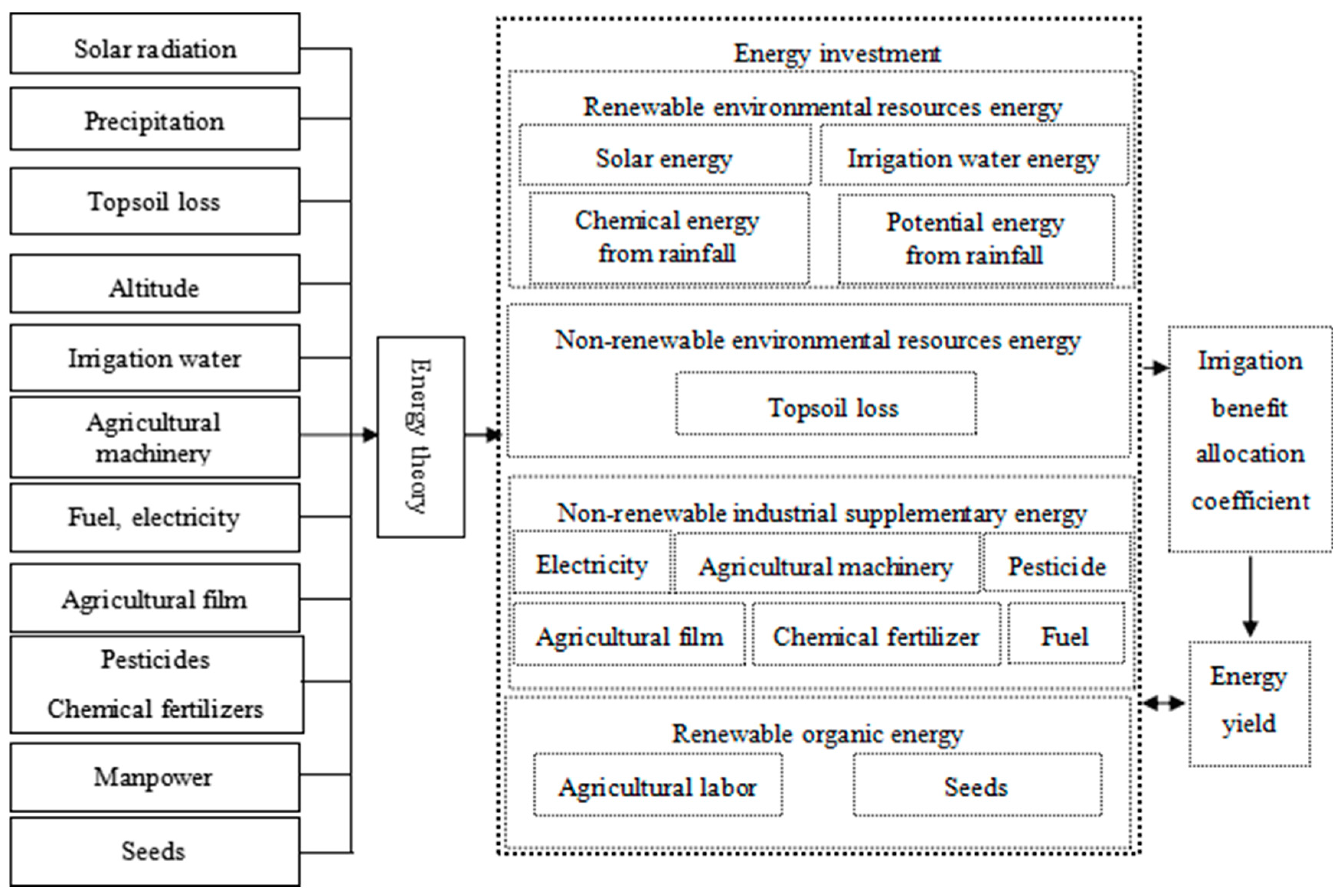
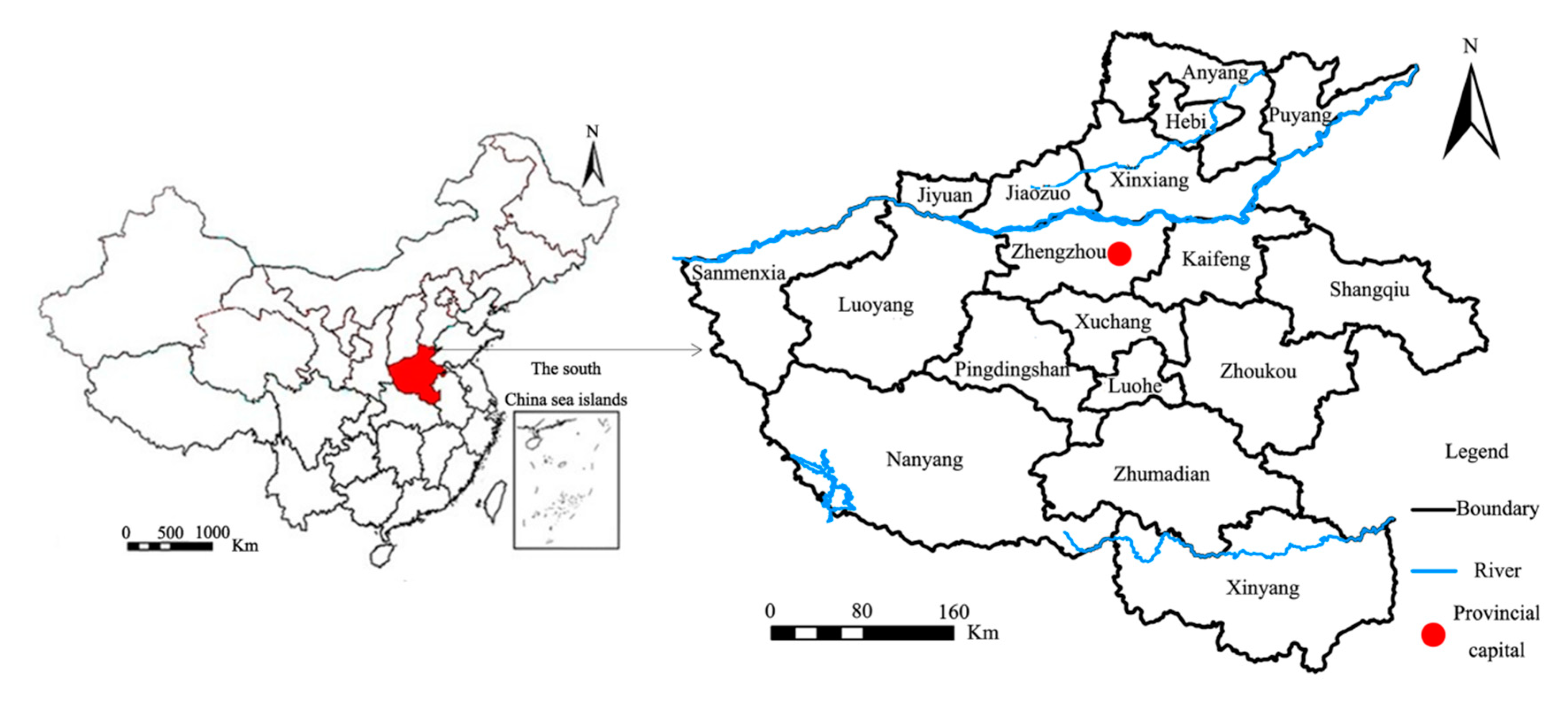

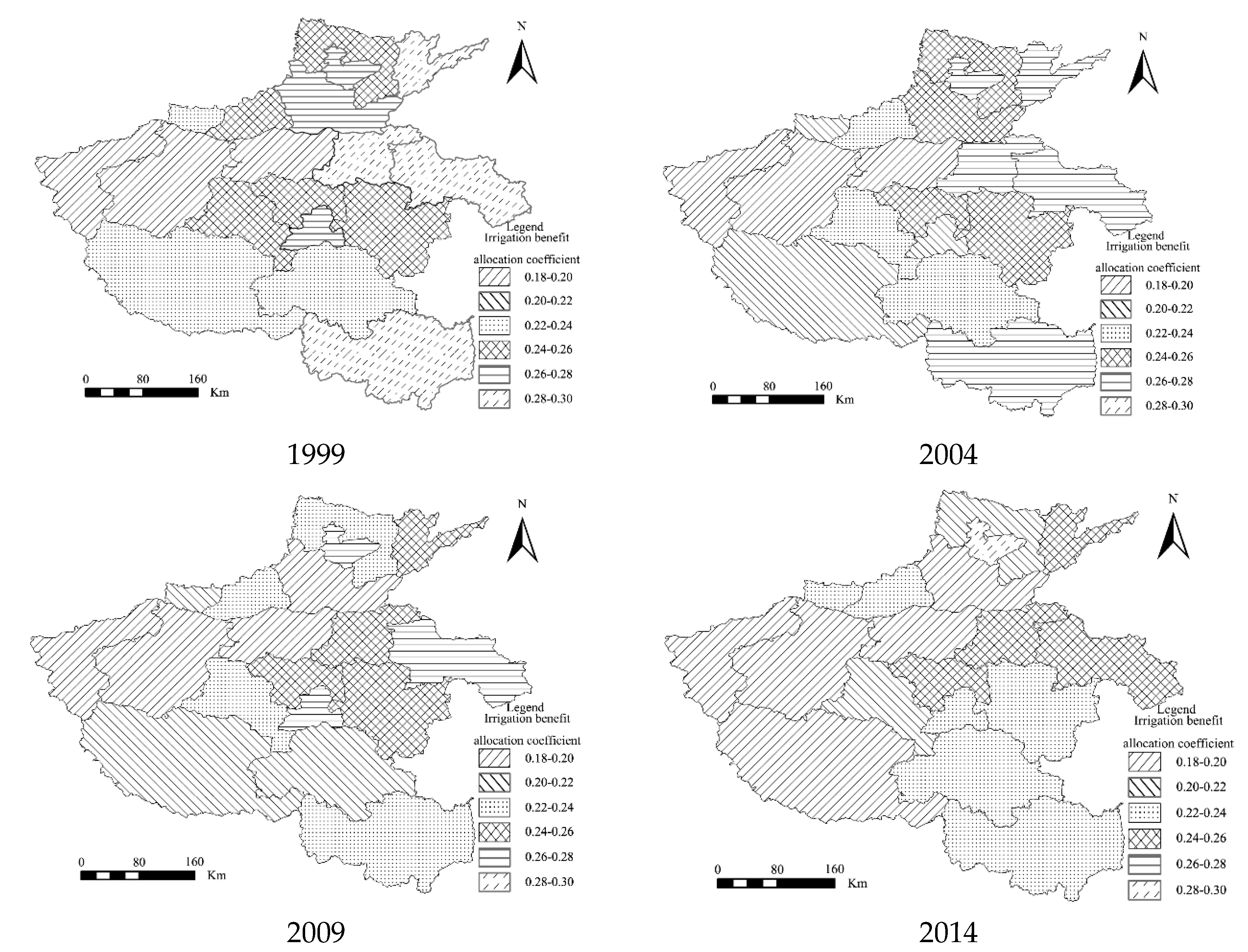
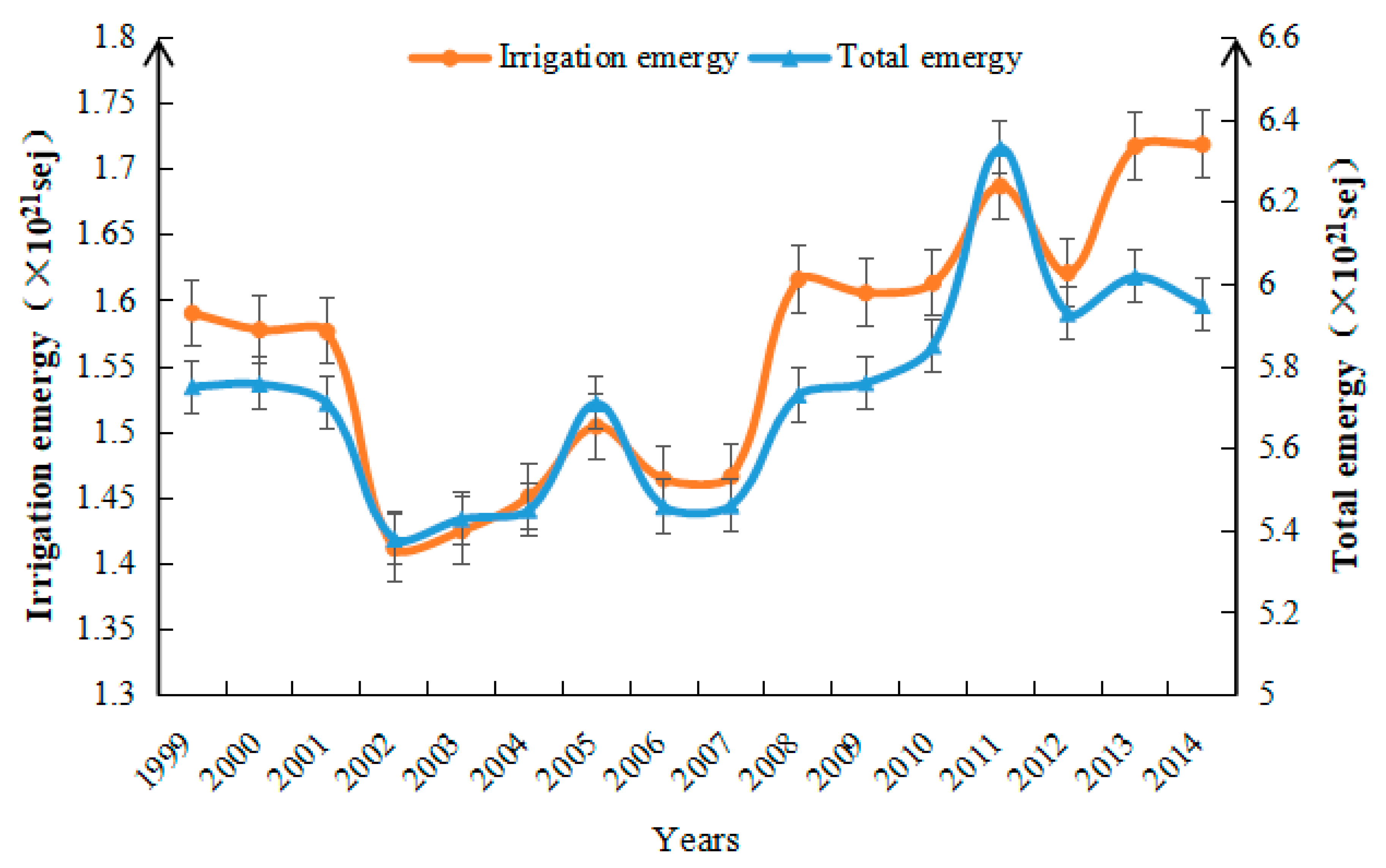
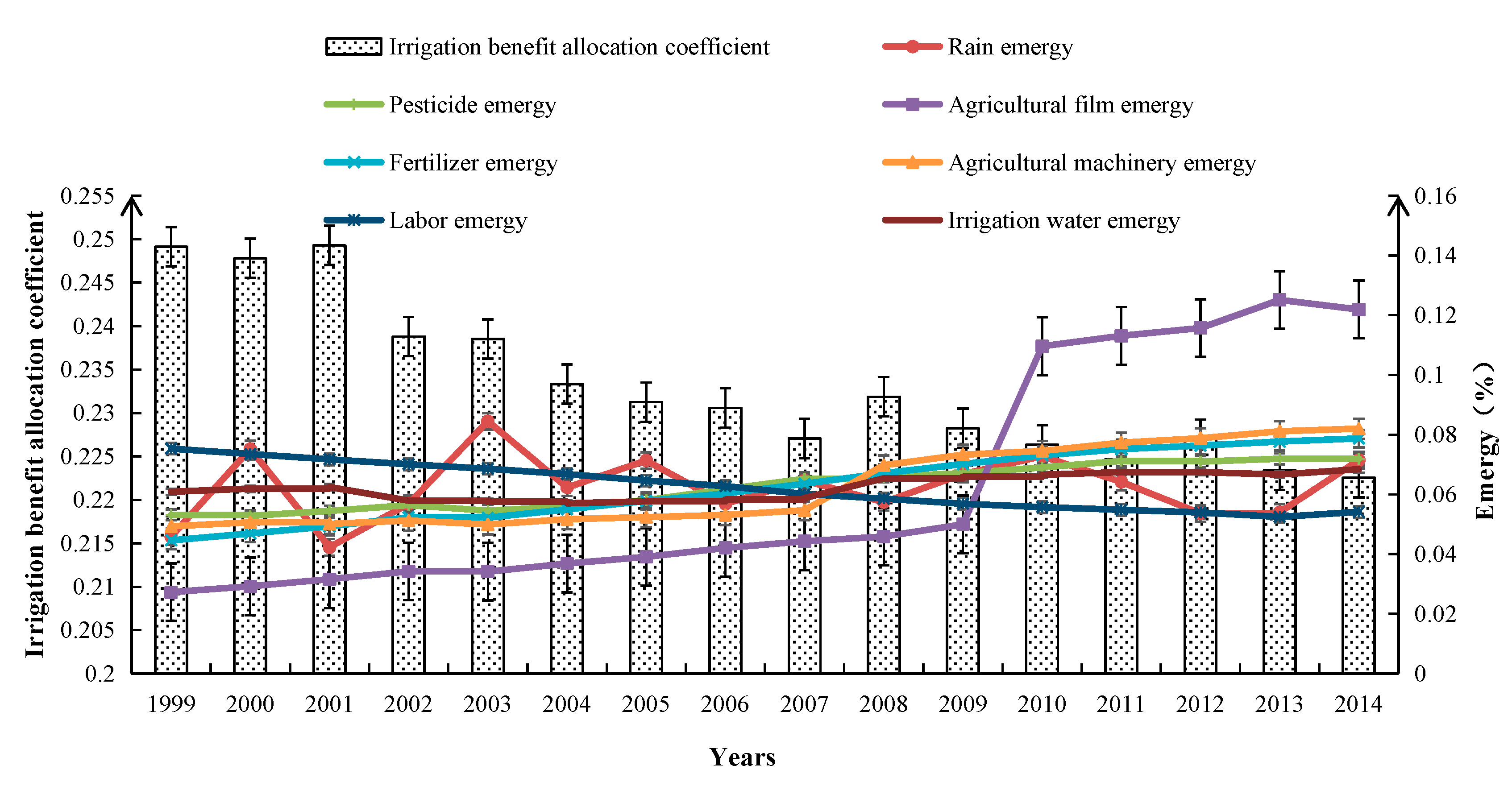
| Category | Source |
|---|---|
| Grain production | Henan Statistical Yearbook China City Statistical Yearbook Henan Rural Statistical Yearbook China Agriculture Yearbook Government gazettes and internal data |
| Farmland | |
| Effective irrigation area | |
| Agricultural tractor-plowed area | |
| Agricultural resource consumption | |
| Agricultural personnel | |
| Solar radiation | China meteorological data-sharing service system |
| Precipitation | |
| Topsoil loss | Studies by other researchers, experimental calculations |
| Item | Emergy Conversion Ratio (seJ/unit) | Crop | Energy Conversion Coefficient (J/kg) | Emergy Conversion Ratio (seJ/unit) |
|---|---|---|---|---|
| Solar energy (J) | 1.00 | Rice (J) | 1.51 × 107 | 8.30 × 104 |
| Chemical energy from rainfall (J) | 1.54 × 104 | Wheat (J) | 1.63 × 107 | 6.80 × 104 |
| Potential energy from rainfall (J) | 8.89 × 103 | Corn (J) | 1.63 × 107 | 2.70 × 104 |
| Topsoil loss (J) | 6.25 × 104 | Soybean (J) | 2.09 × 107 | 8.30 × 104 |
| Irrigation water (m3) | 4.10 × 1012 | Green bean (J) | 1.67 × 107 | 8.30 × 104 |
| Fuel (J/kg) | 0.66 × 107 | Yam (J) | 0.42 × 107 | 8.30 × 104 |
| Electricity (J/kwh) | 1.59 × 107 | Peanut (J) | 2.30 × 107 | 8.60 × 104 |
| Agricultural machinery (J) | 7.50 × 107 | Rapeseed (J) | 2.63 × 107 | 8.60 × 104 |
| Labor (J) | 3.80 × 105 | Sesame (J) | 3.00 × 107 | 8.60 × 104 |
| Organic fertilizer (t) | 4.77 × 1015 | Cotton (J) | 1.67 × 107 | 8.60 × 104 |
| Plastic film (t) | 3.80 × 1014 | Bast fiber (J) | 1.63 × 107 | 8.30 × 104 |
| Pesticide (t) | 1.60 × 1015 | Tobacco (J) | 1.75 × 107 | 20.00 × 104 |
| Seeds (J) | 2.00 × 105 | Vegetable (J) | 2.50 × 107 | 2.70 × 104 |
| - | - | Cucurbit (J) | 1.10 × 107 | 4.30 × 104 |
| Item | 1999 | 2000 | 2001 | 2002 | 2003 | 2004 | 2005 | 2006 | 2007 | 2008 | 2009 | 2010 | 2011 | 2012 | 2013 | 2014 | ||
|---|---|---|---|---|---|---|---|---|---|---|---|---|---|---|---|---|---|---|
| Emergy Investment | Renewable environmental resource emergy | Solar energy × 1020 | 3.71 | 3.73 | 3.75 | 3.95 | 3.91 | 3.90 | 3.91 | 3.91 | 3.91 | 3.86 | 4.30 | 4.30 | 4.30 | 4.30 | 4.43 | 4.44 |
| Potential energy from rainfall × 1020 | 3.33 | 5.46 | 3.06 | 4.14 | 6.10 | 4.49 | 5.16 | 4.11 | 4.67 | 4.16 | 4.88 | 5.32 | 4.69 | 3.92 | 3.96 | 5.24 | ||
| Chemical energy from rainfall × 1021 | 3.19 | 5.23 | 2.94 | 3.96 | 5.88 | 4.33 | 4.97 | 3.95 | 4.50 | 3.99 | 4.60 | 5.06 | 4.46 | 3.73 | 3.75 | 4.97 | ||
| Irrigation water × 1022 | 5.88 | 5.98 | 6.03 | 5.59 | 5.56 | 5.51 | 5.58 | 5.63 | 5.68 | 6.31 | 6.37 | 6.43 | 6.52 | 6.52 | 6.44 | 6.61 | ||
| Non-renewable environmental resource emergy | Topsoil loss × 1021 | 1.95 | 1.89 | 1.96 | 2.05 | 2.01 | 2.03 | 2.21 | 2.10 | 2.09 | 1.93 | 2.45 | 2.23 | 2.24 | 2.44 | 2.49 | 2.98 | |
| Non-renewable industrial emergy | Agricultural machinery × 1023 | 1.71 | 1.75 | 1.73 | 1.77 | 1.73 | 1.79 | 1.81 | 1.84 | 1.89 | 2.41 | 2.53 | 2.58 | 2.67 | 2.73 | 2.81 | 2.83 | |
| Chemical fertilizers × 1022 | 1.91 | 2.01 | 2.11 | 2.23 | 2.23 | 2.35 | 2.47 | 2.58 | 2.72 | 2.87 | 3.00 | 3.13 | 3.21 | 3.26 | 3.32 | 3.37 | ||
| Agricultural film × 1019 | 1.39 | 1.49 | 1.61 | 1.74 | 1.74 | 1.88 | 1.99 | 2.14 | 2.26 | 2.34 | 2.55 | 5.59 | 5.76 | 5.90 | 6.38 | 6.21 | ||
| Pesticides × 1020 | 1.54 | 1.53 | 1.58 | 1.63 | 1.58 | 1.62 | 1.68 | 1.78 | 1.88 | 1.91 | 1.94 | 2.00 | 2.06 | 2.05 | 2.08 | 2.08 | ||
| Fuel × 1014 | 2.30 | 2.31 | 2.43 | 2.47 | 2.46 | 2.52 | 2.61 | 2.70 | 2.80 | 2.88 | 3.02 | 3.13 | 3.23 | 3.26 | 3.29 | 3.36 | ||
| Agricultural electricity × 1022 | 2.44 | 2.50 | 2.68 | 2.81 | 2.88 | 3.13 | 3.42 | 3.75 | 4.45 | 4.72 | 5.12 | 5.35 | 5.60 | 5.76 | 6.07 | 6.23 | ||
| Renewable organic emergy | Agricultural labor × 1022 | 5.24 | 5.11 | 4.99 | 4.88 | 4.77 | 4.65 | 4.49 | 4.37 | 4.18 | 4.08 | 3.96 | 3.88 | 3.81 | 3.75 | 3.65 | 3.76 | |
| Seeds × 1021 | 5.77 | 6.19 | 6.45 | 6.34 | 5.88 | 6.85 | 7.41 | 8.19 | 8.28 | 8.35 | 8.58 | 8.79 | 8.97 | 9.78 | 9.94 | 9.99 | ||
| Emergy Yield | Organic emergy yield | Crop production × 1022 | 7.46 | 7.98 | 8.20 | 8.29 | 7.70 | 8.92 | 9.58 | 10.6 | 10.7 | 10.8 | 11.1 | 11.3 | 11.5 | 12.2 | 12.4 | 12.5 |
| Cities | 1999 | 2000 | 2001 | 2002 | 2003 | 2004 | 2005 | 2006 | 2007 | 2008 | 2009 | 2010 | 2011 | 2012 | 2013 | 2014 |
|---|---|---|---|---|---|---|---|---|---|---|---|---|---|---|---|---|
| Anyang | 0.26 | 0.26 | 0.26 | 0.26 | 0.25 | 0.25 | 0.24 | 0.24 | 0.22 | 0.22 | 0.22 | 0.22 | 0.22 | 0.22 | 0.21 | 0.21 |
| Hebi | 0.28 | 0.27 | 0.28 | 0.26 | 0.26 | 0.27 | 0.26 | 0.27 | 0.27 | 0.28 | 0.28 | 0.28 | 0.27 | 0.27 | 0.29 | 0.29 |
| Jiyuan | 0.23 | 0.23 | 0.22 | 0.22 | 0.21 | 0.21 | 0.21 | 0.21 | 0.21 | 0.22 | 0.21 | 0.21 | 0.22 | 0.21 | 0.24 | 0.23 |
| Jiaozuo | 0.25 | 0.25 | 0.25 | 0.24 | 0.24 | 0.24 | 0.24 | 0.24 | 0.24 | 0.24 | 0.23 | 0.23 | 0.22 | 0.23 | 0.24 | 0.24 |
| Kaifeng | 0.28 | 0.28 | 0.28 | 0.27 | 0.27 | 0.27 | 0.26 | 0.26 | 0.26 | 0.26 | 0.25 | 0.25 | 0.25 | 0.25 | 0.25 | 0.25 |
| Luoyang | 0.19 | 0.19 | 0.19 | 0.18 | 0.17 | 0.17 | 0.17 | 0.17 | 0.17 | 0.17 | 0.17 | 0.17 | 0.17 | 0.17 | 0.17 | 0.17 |
| Luohe | 0.27 | 0.28 | 0.27 | 0.27 | 0.27 | 0.21 | 0.21 | 0.20 | 0.20 | 0.27 | 0.27 | 0.26 | 0.26 | 0.25 | 0.24 | 0.23 |
| Nanyang | 0.22 | 0.22 | 0.22 | 0.20 | 0.20 | 0.20 | 0.20 | 0.20 | 0.20 | 0.20 | 0.20 | 0.20 | 0.20 | 0.20 | 0.20 | 0.20 |
| Pingdingshan | 0.24 | 0.23 | 0.24 | 0.23 | 0.23 | 0.23 | 0.23 | 0.23 | 0.23 | 0.23 | 0.23 | 0.23 | 0.23 | 0.22 | 0.21 | 0.22 |
| Puyang | 0.28 | 0.28 | 0.28 | 0.27 | 0.27 | 0.27 | 0.26 | 0.26 | 0.26 | 0.25 | 0.25 | 0.25 | 0.25 | 0.25 | 0.25 | 0.25 |
| Sanmenxia | 0.19 | 0.19 | 0.19 | 0.19 | 0.19 | 0.19 | 0.19 | 0.19 | 0.19 | 0.19 | 0.19 | 0.19 | 0.19 | 0.19 | 0.18 | 0.18 |
| Shangqiu | 0.30 | 0.30 | 0.29 | 0.27 | 0.27 | 0.27 | 0.26 | 0.26 | 0.26 | 0.28 | 0.27 | 0.27 | 0.26 | 0.26 | 0.25 | 0.25 |
| Xinxiang | 0.27 | 0.26 | 0.27 | 0.26 | 0.26 | 0.25 | 0.24 | 0.23 | 0.20 | 0.21 | 0.19 | 0.19 | 0.19 | 0.19 | 0.19 | 0.19 |
| Xinyang | 0.30 | 0.30 | 0.31 | 0.28 | 0.28 | 0.28 | 0.28 | 0.28 | 0.27 | 0.24 | 0.24 | 0.24 | 0.23 | 0.23 | 0.23 | 0.23 |
| Xuchang | 0.26 | 0.26 | 0.26 | 0.25 | 0.25 | 0.26 | 0.25 | 0.26 | 0.26 | 0.25 | 0.25 | 0.25 | 0.24 | 0.31 | 0.25 | 0.24 |
| Zhengzhou | 0.19 | 0.19 | 0.18 | 0.17 | 0.17 | 0.16 | 0.16 | 0.17 | 0.16 | 0.18 | 0.17 | 0.18 | 0.18 | 0.18 | 0.18 | 0.18 |
| Zhoukou | 0.26 | 0.26 | 0.26 | 0.26 | 0.26 | 0.26 | 0.25 | 0.25 | 0.25 | 0.25 | 0.25 | 0.25 | 0.25 | 0.24 | 0.22 | 0.23 |
| Zhumadian | 0.23 | 0.23 | 0.23 | 0.23 | 0.22 | 0.23 | 0.23 | 0.24 | 0.24 | 0.22 | 0.22 | 0.22 | 0.22 | 0.22 | 0.21 | 0.22 |
| Type | IBAC | RE | PE | AFE | CFE | AME | LE | IWE |
|---|---|---|---|---|---|---|---|---|
| IBAC | 1.00 | −0.26 | −0.89 | −0.74 | −0.92 | −0.77 | 0.94 | −0.47 |
| RE | −0.26 | 1.00 | 0.03 | 0.05 | 0.12 | 0.04 | −0.12 | −0.09 |
| PE | −0.89 | 0.03 | 1.00 | 0.88 | 0.99 | 0.94 | −0.98 | 0.79 |
| AFE | −0.74 | 0.05 | 0.88 | 1.00 | 0.90 | 0.91 | −0.84 | 0.81 |
| CFE | −0.92 | 0.11 | 0.99 | 0.90 | 1.00 | 0.95 | −0.99 | 0.77 |
| AME | −0.77 | 0.04 | 0.94 | 0.91 | 0.95 | 1.00 | −0.91 | 0.91 |
| LE | 0.94 | −0.12 | −0.98 | −0.84 | −0.99 | −0.91 | 1.00 | −0.71 |
| IWE | −0.47 | −0.09 | 0.79 | 0.81 | 0.77 | 0.91 | −0.71 | 1.00 |
© 2018 by the authors. Licensee MDPI, Basel, Switzerland. This article is an open access article distributed under the terms and conditions of the Creative Commons Attribution (CC BY) license (http://creativecommons.org/licenses/by/4.0/).
Share and Cite
Wang, K.; Zhang, P.; Pang, B. Process and Mechanism of Agricultural Irrigation Benefit Allocation Coefficient Based on Emergy Analysis—A Case Study of Henan, China. Sustainability 2018, 10, 4436. https://doi.org/10.3390/su10124436
Wang K, Zhang P, Pang B. Process and Mechanism of Agricultural Irrigation Benefit Allocation Coefficient Based on Emergy Analysis—A Case Study of Henan, China. Sustainability. 2018; 10(12):4436. https://doi.org/10.3390/su10124436
Chicago/Turabian StyleWang, Kaiyong, Pengyan Zhang, and Bo Pang. 2018. "Process and Mechanism of Agricultural Irrigation Benefit Allocation Coefficient Based on Emergy Analysis—A Case Study of Henan, China" Sustainability 10, no. 12: 4436. https://doi.org/10.3390/su10124436
APA StyleWang, K., Zhang, P., & Pang, B. (2018). Process and Mechanism of Agricultural Irrigation Benefit Allocation Coefficient Based on Emergy Analysis—A Case Study of Henan, China. Sustainability, 10(12), 4436. https://doi.org/10.3390/su10124436





